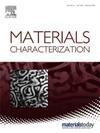Strain partitioning characterization of advanced high strength steels using in-situ tensile tests with Micro digital image correlation – Methodology and analysis
IF 4.8
2区 材料科学
Q1 MATERIALS SCIENCE, CHARACTERIZATION & TESTING
引用次数: 0
Abstract
This research investigates experimental methods used to extract and quantify meso-scale strain partitioning of five different advanced high strength steels (AHSS), using in-situ uniaxial tensile testing within a SEM. A slightly notched uniaxial tensile specimen was developed to ensure that localisation (necking) occurred in the middle of the specimen where SEM images of the deformed microstructures were captured. Micro digital image correlation (μDIC) was conducted using the etched microstructure up to high nominal strain of ∼0.5 within the neck. The effect of step size, subset size and SEM magnification were investigated to produce the highest resolution strain distribution contours. The strain distribution throughout the microstructure was extracted from 10,000× magnification micrographs and a method was developed to quantify the average strain partitioning for every level of nominal strain imposed during the tensile test. The high strength differential between ferrite and martensite grains within two dual-phase steels (DP800, DP980GI), resulted in a high level of average strain partitioning that increased linearly with respect to the applied nominal strain. The three-phase (martensite-bainite-ferrite) CP980 steel had a similar (to DP) level of strain partitioning at low nominal strains, but as deformation within the neck increased, the rate of strain partitioning decreased due to the presence of the moderate strength bainite grains. Single-phase MS1500 (martensite) and TWIP (retained austenite) exhibited low average strain partitioning levels due the single-phase and large grain size microstructures of these materials. The average strain partitioning ratio was shown to be ∼1 for the dual-phase steels, and reduced to 0.45 for the highest ductility TWIP material.
利用微数字图像相关性原位拉伸试验表征先进高强度钢的应变分区--方法与分析
本研究通过在扫描电子显微镜内进行原位单轴拉伸测试,调查用于提取和量化五种不同高级高强度钢(AHSS)中观尺度应变分区的实验方法。我们制作了一个略有缺口的单轴拉伸试样,以确保在试样中部发生局部化(颈缩),并在此捕捉变形微结构的扫描电镜图像。使用蚀刻微观结构进行了微观数字图像相关性(μDIC)分析,结果表明颈部的标称应变高达 0.5。研究了步长、子集尺寸和 SEM 放大倍率的影响,以生成最高分辨率的应变分布轮廓。从 10,000 倍放大率的显微照片中提取了整个微结构的应变分布,并开发了一种方法来量化拉伸试验期间施加的每一级标称应变的平均应变分区。在两种双相钢(DP800、DP980GI)中,铁素体和马氏体晶粒之间的强度差异很大,导致平均应变分区水平很高,与施加的名义应变呈线性增长。三相钢(马氏体-贝氏体-铁素体)CP980 在低名义应变下的应变分配水平与 DP 相似,但随着颈部变形的增加,由于存在中等强度的贝氏体晶粒,应变分配率下降。单相 MS1500(马氏体)和 TWIP(残余奥氏体)的平均应变分配水平较低,这是因为这些材料具有单相和大晶粒尺寸的微观结构。双相钢的平均应变分配比为 1 ∼ 1,而延展性最高的 TWIP 材料的平均应变分配比则降至 0.45。
本文章由计算机程序翻译,如有差异,请以英文原文为准。
求助全文
约1分钟内获得全文
求助全文
来源期刊

Materials Characterization
工程技术-材料科学:表征与测试
CiteScore
7.60
自引率
8.50%
发文量
746
审稿时长
36 days
期刊介绍:
Materials Characterization features original articles and state-of-the-art reviews on theoretical and practical aspects of the structure and behaviour of materials.
The Journal focuses on all characterization techniques, including all forms of microscopy (light, electron, acoustic, etc.,) and analysis (especially microanalysis and surface analytical techniques). Developments in both this wide range of techniques and their application to the quantification of the microstructure of materials are essential facets of the Journal.
The Journal provides the Materials Scientist/Engineer with up-to-date information on many types of materials with an underlying theme of explaining the behavior of materials using novel approaches. Materials covered by the journal include:
Metals & Alloys
Ceramics
Nanomaterials
Biomedical materials
Optical materials
Composites
Natural Materials.
 求助内容:
求助内容: 应助结果提醒方式:
应助结果提醒方式:


